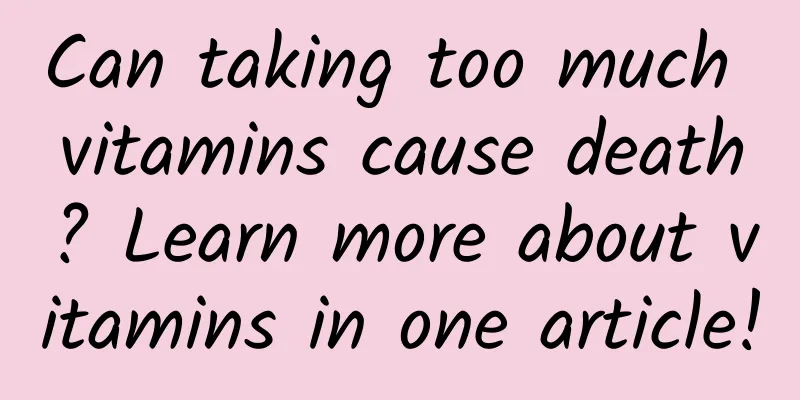Can taking too much vitamins cause death? Learn more about vitamins in one article!

|
In November 1912, an expedition team consisting of three people and six dogs sailed into the heart of Antarctica to investigate the ice cracks that stretched for hundreds of kilometers. A month later, a member of the expedition and a sled loaded with supplies accidentally fell into an ice crevasse. The remaining two members had to make a difficult decision to survive - eat their dog. But something strange happened. Both members began to have stomach pain, diarrhea, and skin and hair falling off . Soon, one member died. In the end, only one member returned to the camp dying. What happened? Was it revenge of the dog that was eaten? Later, people found out that it was the rich vitamin A in the dog's liver that killed the second expedition member. Why? Copyright image, no permission to reprint What exactly are vitamins? Vitamins are a large class of organic substances that are necessary for human growth . Our bodies cannot synthesize these organic substances, so they can only be obtained from food . Although our bodies cannot synthesize them, we really cannot live without them. For example, vitamin A is essential for our vision because it is required for the synthesis of rhodopsin [2]. If ordinary people lack vitamin A, they may suffer from night blindness and be unable to see clearly at night. According to statistics from the World Health Organization, approximately 250 million preschool children worldwide do not have adequate vitamin A intake, resulting in approximately 250,000 to 500,000 children becoming blind each year due to vitamin A deficiency[3]. Vitamin C is essential in the synthesis of collagen, L-carnitine, and some neurotransmitters, and also plays an important role in the metabolism of various proteins[4]. During the Age of Exploration (15th-17th centuries), at least 2 million sailors died of scurvy due to vitamin C deficiency [5]. Vitamin D can promote intestinal calcium absorption and maintain blood calcium concentration . It is essential for preventing convulsions caused by calcium deficiency and for normal bone development[6]. Copyright image, no permission to reprint It can be said that it is most appropriate to call them vitamins! Vitamin Supplement Frenzy Given that vitamins are essential to our health, people have known since ancient times the need to consume the right amount of them . For example, the Vikings living in Scandinavia, due to their high latitude, received very limited sunlight, and sunbathing is an important way for humans in most areas to supplement vitamin D. Therefore, living in such a place for a long time would cause many Vikings to suffer from rickets caused by vitamin D deficiency. In response to this, the Vikings adopted another way to obtain vitamin D. They boiled cod livers to make cod liver oil rich in vitamin D. Today, the various "fish oils" we see in the health care product market also come from this. Copyright image, no permission to reprint Another vitamin that has brought the concept of vitamin supplementation to a climax is the famous vitamin C. In 1747, James Lind discovered through experiments that fresh fruit was effective in treating scurvy. He recorded this in a treatise on scurvy published in 1753. Although the exact ingredients were unknown at the time, since the mid-19th century, the ration list of sailors on long voyages of the British Empire has included lemons to supplement the vitamin C they need . But the person who really made vitamin C become a god was a heavyweight figure, Linus Pauling. Pauling won the 1954 Nobel Prize in Chemistry for his outstanding contributions to the field of chemical bonds, and the 1962 Nobel Peace Prize for his anti-nuclear weapons movement. As one of the few two-time Nobel Prize winners, people believed what he said. Pauling once took large amounts of vitamin C on the recommendation of Irwin Stone (an expert in the field of biochemistry) to "extend life." In an "observation experiment" of taking 3 grams of vitamin C per day, Pauling concluded that vitamin C can indeed "strengthen the body." In 1970, he also published a book called "Vitamin C and Colds," in which Pauling advocated that Americans should also take 3 grams of vitamin C every day. Once the book was published, the sales of vitamin C in the United States increased tenfold in one year [7]. Under Pauling's leadership, people took large doses of vitamin C with full confidence, believing that vitamin C could cure various diseases ranging from colds to AIDS. Copyright image, no permission to reprint But Pauling’s “personal experience” is not the same as scientific research. In subsequent studies, people did not find that vitamin C can effectively prevent colds. However, a 2013 study did find that taking 200 mg of vitamin C per day can make you recover from a cold faster, but only by half a day [8] (8% of the infection period). And of course, the magical effect of "curing all diseases" no longer exists. Do you really need to take vitamin supplements? Although the effectiveness of vitamin supplements has not been scientifically proven, today the market share of vitamin-related health products has reached $25 billion[9]. A quick search for vitamins on the Internet will reveal a wide variety of vitamin supplements and multivitamin tablets. But do we really need vitamin supplements? In fact, as people’s living conditions have improved, we can now eat all kinds of food we want in any season. And these daily diets can also meet the vitamin needs of most people[10]. But some people may still think, I don’t know if my diet is balanced enough, I might as well take some vitamin capsules just in case! Copyright image, no permission to reprint But when it comes to vitamins, the more you take, the better. The Dietary Reference Intakes for Chinese Residents provides recommended daily intakes and maximum tolerable intakes (partially) for the vitamins we need [11]. For example, the recommended daily intake of vitamin C, which Pauling strongly recommended, is only 100 mg, while the maximum tolerable intake is 2000 mg (or 2 grams). Pauling consumed 3 grams per day, which was far more than this amount. Excessive intake of vitamin C may cause adverse reactions such as diarrhea, nausea, and stomach cramps [12]. Swedish scientists have also found that the incidence of kidney stones in people who consume excessive amounts of vitamin C is twice as high as that of ordinary people[13]. The consequences of excessive intake of vitamin C are relatively minor , because vitamin C and various vitamins in the vitamin B family are water-soluble vitamins . Once consumed in excess, the excess vitamins are easily excreted in the urine, and the impact on the body is relatively small. As for fat-soluble vitamins, if they are taken in excess, they may have even more serious consequences. For example, long-term excessive intake of vitamin D may lead to adverse reactions such as high blood calcium, impaired kidney and heart function[14]; the most terrifying is vitamin A. Although the cases of death from vitamin A overdose mentioned above are relatively rare, excessive intake of vitamin A can cause dizziness, nausea, headache, and coma[15], and may also cause osteoporosis in the elderly. Excessive intake of vitamin A by pregnant women may harm the fetus[16]. What is frustrating is that there are so many vitamin supplements that are not prescription drugs, which means that anyone can easily get them. The merchants will only continue to emphasize the consequences of lacking certain vitamins, but will not tell you that there are also problems with excessive intake of vitamins. This will give people a misunderstanding - if you don't know whether you have enough vitamins, then take some, just in case. How do you know if you are eating enough? I understand the principle, but how do I know if I am taking enough vitamins? For the general population, it is recommended that: 300-500 grams of milk and dairy products, 25-35 grams of soy and nuts per day; 200-300 grams of cereals per day, including 50-150 grams of whole grains and beans; More than 120-200 grams of animal food such as meat, fish, eggs, etc. per day; 300-500 grams of vegetables and 200-350 grams of fruit per day; 1 egg a day and seafood at least twice a week. This can basically meet your daily vitamin needs. Compare this to see if what you eat is "balanced" and "nutritious" enough! Copyright image, no permission to reprint Of course, there are not many foods rich in vitamin D in nature. Although sunbathing can supplement vitamin D, if you are in the rainy season or in the winter when there is less sunlight, it is okay to supplement it in moderation. However, before taking various supplements, please read the instructions carefully and do not abuse them. Therefore, after understanding the other side of vitamins, we should look at vitamins more carefully. The real health product is probably a "balanced diet"! References: [1]https://www.smithsonianmag.com/history/the-most-terrible-polar-exploration-ever-douglas-mawsons-antarctic-journey-82192685/ [2]https://ods.od.nih.gov/factsheets/VitaminA-HealthProfessional/#en2 [3] http://www.who.int/nutrition/topics/vad/en/ [4]https://ods.od.nih.gov/factsheets/VitaminC-HealthProfessional/ [5] Drymon, MM (2008). Disguised As the Devil: How Lyme Disease Created Witches and Changed History. Wythe Avenue Press, p 114 [6]https://ods.od.nih.gov/factsheets/VitaminD-HealthProfessional/ [7]https://news.google.com/newspapers?id=YQFYAAAAIBAJ&sjid=JfcDAAAAIBAJ&pg=1606%2C3995923 [8] Douglas RM, Hemilä H. Vitamin C for preventing and treating the common cold[J]. PLoS medicine, 2005, 2(6): e168. [9]https://www.statista.com/statistics/748226/global-consumer-vds-sales-by-product/ [10]https://www.nhs.uk/common-health-questions/food-and-diet/do-i-need-vitamin-supplements/ [11] Dietary Reference Intakes of Nutrients for Chinese Residents (WS/T 578.5—2018) [12]https://ods.od.nih.gov/factsheets/VitaminC-Consumer/ [13] Thomas LDK, Elinder CG, Tiselius HG, et al. Ascorbic acid supplements and kidney stone incidence among men: a prospective study[J]. JAMA internal medicine, 2013, 173(5): 386-388. [14] https://www.nhs.uk/conditions/vitamins-and-minerals/vitamin-d/ [15]https://ods.od.nih.gov/factsheets/VitaminA-Consumer/ [16] https://www.nhs.uk/conditions/vitamins-and-minerals/vitamin-a/ Author|Science Scraps Review | Zhang Na, Associate Researcher, Doctoral Supervisor, Peking University School of Public Health Produced by: Science Popularization China-Creation Cultivation Program The cover image and the images in this article are from the copyright library Reproduction of image content is not authorized |
<<: Why do humans love to use electricity?
>>: How did people open cans when there were no cans?
Recommend
Comparison between server memory and normal memory
Server memory is also memory (RAM). There is no o...
Have you ever taken one of these high-tech buses?
The environment in big cities is getting worse an...
React Native vs. Kotlin: A Quick Comparison
Mobile applications have become an emerging platf...
How should products and operations use big data for conversion analysis?
In the many marketing copy screen-sweeping incide...
The location of Wenchang Tower before the exam
Many parents are very concerned about their child...
How can new marketers quickly understand the characteristics of online marketing channels?
We have compiled 16 mainstream online promotion c...
Is Maiqiu'er's explanation of the residue reliable?
In response to the milk quality issue that has at...
How to build a reasonable advertising account structure?
Some people may ask after seeing this topic, the ...
HTC: It doesn’t have Apple’s fate, but it has Apple’s diseases!
As a manufacturer in the mobile phone circle, it ...
Be careful! Feeling sleepy all the time may be a sign of illness
Expert of this article: Guo Xiangping, Deputy Sec...
Huawei Qiankun Intelligent Driving helps the city and the wild, smart and brave hardcore SUV Fangcheng Baobao 8 to be launched
On November 12, BYD and Huawei jointly launched t...
Night reading: 4 effective ways to get rid of "mental exhaustion"
Once when I was chatting with a friend, she said ...
Why is it difficult for your solution to effectively solve the problem?
When you encounter any marketing problem, your ma...
Bringing the "sky" to the ground, he "blasted" a new path for Chinese wind tunnels
"I think the country is so poor, can you spe...
How to place a good advertisement? How to acquire customers at low cost?
1 The purpose of advertising is either branding o...









